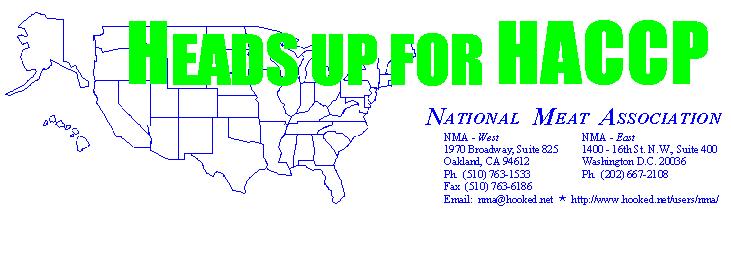

Edited by Jeremy Russell
April 6, 1998
HACCP Principle #6: Establish Recordkeeping Procedures
RECORDKEEPING
The Keystone HACCP Principle, by Teresa Frey, NMA Regulatory Aide
HACCP without recordkeeping is like a car without oil. A HACCP plan will not run properly run and will eventually stall without proper record. Clear, concise recordkeeping can be an establishment�s best asset. Confusing, sloppy and incomplete records may become a worst enemy of a plant. A plant may have the best sanitary practices, the most controlled CCP�s and the most stringent monitoring procedures, but if it isn�t recorded, it didn�t happen.
9 CFR � 417.4 states that the establishment shall maintain the following HACCP records:
Records should be made as "real-time" entries and be dated and signed or initialed by the establishment employee making the entry. "Dry-lab" entries are not acceptable.
Prior to shipping product, all records associated with the production of that product must be reviewed to ensure that all critical limits were met and, if appropriate corrective actions were taken. Where practical, this record check should be made by plant employee who did not make the original entries. It is important to note that the regulations do not define how plants meet this requirement. Therefore, plants may establish a record review system that best fits the needs of its facility. However, establishments must determine that all critical limits were met and that corrective actions were taken prior to product shipment.
Records may be maintained on computers provided that appropriate controls are implemented to insure the integrity of the electronic data and signatures.
An establishment�s written Hazard Analysis, decision-making documents supporting selection of CCPs and establishing critical limits, and documents supporting both the monitoring and verification procedures, and the frequency of those procedures must be maintained on-site indefinitely.
Records associated with monitoring, corrective actions and verification procedures for slaughter activities and refrigerated product must be mantained for at least one year. Records associated with monitoring, corrective actions and verification procedures for frozen preserved, or shelf stable products must be maintained for at least two years. These must be kept on the premises of
the establishment for a period of six months. After the six-month period, records may be relocated to an off-site storage provided that they can be retrieved within 24 hours of an FSIS employee�s request.
Periodic review of HACCP records can provide plant management with insight into processing trends. After all, FSIS will be periodically reviewing your records. Why shouldn�t you?
HACCP plans, procedures and records required by the final rule shall be available for inspection review and copying. It is important to note that while the inspector has the right of access and the right to copy records, the inspector does not have the right to take records. Allowing the inspector to have the only copy of any record may prove disastrous should the record subsequently be lost or destroyed.
Practical Suggestions on Records
by Dennis Johnson, Esq. Olsson, Frank and Weeda, P.C.